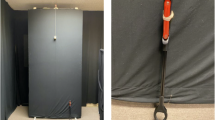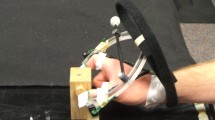Abstract
The literatures on affordance perception and psychophysics are seminal in the basic study of perception and action. Nevertheless, the application of classic psychophysical methodologies/analysis to the study of affordance perception remains unexplored. In four experiments, we investigated the Stevens’ power law scaling of affordance perception. Participants reported maximum forward reaching ability with a series of rods (both seated and standing) for themselves and another person (confederate). Participants also reported a property of the rod set that has been explored in previous psychophysical experiments and changes in equal measure with forward reach-with-ability (length). In all, we found that affordance perception reports (β = .32) were an underaccelerated function of actual changes in reaching ability compared with relatively less accelerated length reports (β = .73). Affordance perception scaled with stimulus magnitude more similarly to brightness perception than length perception. Furthermore, affordance perception reports scaled similarly regardless of the actor (self and other), task context (seated and standing), or idiosyncrasies of the measurement procedure (controlling for distance compression effects), while length perception reports were sensitive to location/distance compression effects. We offer empirical and theoretical considerations, along with pathways for future research.


Similar content being viewed by others
Change history
15 June 2023
Misplaced apostrophe in name corrected from Steven's to Stevens' in title and throughout article.
Notes
We excluded the length reports from Experiment 3, since those were biased by the range effect described earlier.
References
Auerbach, C. (1971). Interdependence of Stevens’ exponents and discriminability measures. Psychological Review, 78(6), 556.
Barsingerhorn, A. D., Frank, T. J. M., Zaal, Smith, J., & Pepping, G. (2012). On possibilities for action: The past, present, and future of affordance research. The Journal of the Philosophical-Interdisciplinary Vanguard, 3, 54–69.
Bernasconi, M., & Seri, R. (2016). What are we estimating when we fit Stevens’ power law? Journal of Mathematical Psychology, 75, 137–149.
Bingham, G. P., & Stassen, M. G. (1994). Monocular egocentric distance information generated by head movement. Ecological Psychology, 6(3), 219–238.
Butler, A. A., Lord, S. R., & Fitzpatrick, R. C. (2011). Reach distance but not judgment error is associated with falls in older people. Journals of Gerontology Series A: Biomedical Sciences and Medical Sciences, 66(8), 896–903.
Carello, C., Grosofsky, A., Reichel, F. D., Solomon, H. Y., & Turvey, M. T. (1989). Visually perceiving what is reachable. Ecological Psychology, 1(1), 27–54.
Creem-Regehr, S. H., Gagnon, K. T., Geuss, M. N., & Stefanucci, J. K. (2013). Relating spatial perspective taking to the perception of other’s affordances: Providing a foundation for predicting the future behavior of others. Frontiers in Human Neuroscience, 7, Article 596. https://doi.org/10.3389/fnhum.2013.00596
Duncan, P. W., Weiner, D. K., Chandler, J., & Studenski, S. (1990). Functional reach: A new clinical measure of balance. Journal of gerontology, 45(6), M192–M197.
Engen, T., & Levy, N. (1955). The influence of standards on psychophysical judgments. Perceptual and Motor Skills, 5(3), 193–197.
Fagot, R. F., & Pokorny, R. (1989). Bias effects on magnitude and ratio estimation power function exponents. Perception & Psychophysics, 45(3), 221–230.
Fechner, G. (1966). Elements of psychophysics (Vol. 1). Holt, Rinehart and Winston. (Original work published 1860)
Gabbard, C., Robinovitch, S. N., & Cronin, T. (1999). Perception of postural limits in elderly nursing home and day care participants. Journals of Gerontology Series A: Biomedical Sciences and Medical Sciences, 54(3), B124–B130.
Gabbard, C., Cordova, A., & Lee, S. (2007). Examining the effects of postural constraints on estimating reach. Journal of Motor Behavior, 39(4), 242–246.
Gibson, J. J. (1966a). The problem of temporal order in stimulation and perception. The Journal of Psychology, 62, 141–149.
Gibson, J. J. (1966b). The senses considered as perceptual systems. Houghton Mifflin.
Gibson, J. J. (1979). The ecological approach to visual perception. Houghton Mifflin.
Kowal, K. H. (1993). The range effect as a function of stimulus set, presence of a standard, and modulus. Perception & Psychophysics, 54(4), 555–561.
Lopresti-Goodman, S. M., Turvey, M. T., & Frank, T. D. (2013). Negative hysteresis in the behavioral dynamics of the affordance “graspable.” Attention, Perception, & Psychophysics, 75, 1075–1091.
Mantel, B., Stoffregen, T. A., Campbell, A., & Bardy, B. G. (2015). Exploratory movement generates higher-order information that is sufficient for accurate perception of scaled egocentric distance. PLOS ONE, 10(4), Article e0120025.
Mark, L. S. (1987). Eyeheight-scaled information about affordances: A study of sitting and stair climbing. Journal of Experimental Psychology: Human Perception and Performance, 13(3), 361–370.
Marsh, K. L., Johnston, L., Richardson, M. J., & Schmidt, R. C. (2009). Toward a radically embodied, embedded social psychology. European Journal of Social Psychology, 39(7), 1217–1225.
Molski, M. (2011). Extended Stevens’ power law. Physiology & Behavior, 104(5), 1031–1036.
Pradham, P. L., & Hoffman, P. J. (1963). Effect of spacing and range of stimuli on magnitude estimation judgements. Journal of Experimental Psychology, 66(6), 533–541.
Ramenzoni, V. C., Riley, M. A., Shockley, K., & Davis, T. (2008). An information-based approach to action understanding. Cognition, 106(2), 1059–1070.
Soper, D. S. (2021). A-priori sample size calculator for student t-tests [Computer software]. Available from https://www.danielsoper.com/statcalc
Shockley, K., Carello, C., & Turvey, M. T. (2004). Metamers in the haptic perception of heaviness and moveableness. Perception & Psychophysics, 66(5), 731–742. https://doi.org/10.3758/bf03194968
Stevens, S. S. (1953). On the brightness of lights and the loudness of sounds. Science, 118, 576–579.
Stevens, S. S. (1957). On the psychophysical law. Psychological Review, 64(3), 153–181.
Stevens, S. S. (1960). The psychophysics of sensory function. American Scientist, 48(2), 226–253.
Stevens, S. S. (1975). Psychophysics: Introduction to its perceptual, neural, and social prospects. Wiley.
Stevens, S. S., & Galanter, E. H. (1957). Ratio scales and category scales for a dozen perceptual continua. Journal of Experimental Psychology, 54(6), 377–411.
Stevens, S. S., & Guirao, M. (1963). Subjective scaling of length and area and the matching of length to loudness and brightness. Journal of Experimental Psychology, 66(2), 177–186.
Stevens, J. C., & Stevens, S. S. (1963). Brightness function: Effects of adaptation. JOSA, 53(3), 375–385.
Streit, M., Shockley, K., Morris, A. W., & Riley, M. A. (2007a). Rotational kinematics influence multimodal perception of heaviness. Psychonomic Bulletin & Review, 14(2), 363–367. https://doi.org/10.3758/BF03194078
Streit, M., Shockley, K., & Riley, M. A. (2007b). Rotational inertia and multimodal heaviness perception. Psychonomic Bulletin & Review, 14(5), 1001–1006.
Thomas, B. J., & Riley, M. A. (2014). Remembered affordances reflect the fundamentally action-relevant, context-specific nature of visual perception. Journal of Experimental Psychology: Human Perception and Performance, 40, 2361–2371.
Thomas, B. J., & Riley, M. A. (2015). The selection and usage of information for perceiving and remembering intended and unintended object properties. Journal of Experimental Psychology: Human Perception and Performance, 41, 807–815.
Thomas, B. J., Wagman, J. B., Hawkins, M. M., Havens, M., & Riley, M. A. (2016). The independent perceptual calibration of action-neutral and -referential environmental properties. Perception, 46(5), 586–604.
Turvey, M. T., Shockley, K., & Carello, C. (1999). Affordance, proper function, and the physical basis of perceived heaviness. Cognition, 73(2), B17–B26.
Wagman, J. B. (2019). A guided tour of Gibson’s theory of affordances. In J. B. Wagman & J. J. C. Blau (Eds.), Perception as information detection: Reflections on Gibson’s Ecological Approach to perception (pp. 233–247). Routledge.
Wagman, J. B., & Carello, C. (2003). Haptically creating affordances: The user-tool interface. Journal of Experimental Psychology: Applied, 9(3), 175–187.
Wagman, J. B., & Shockley, K. (2011). Metamers for hammer-with-ability are not metamers for poke-with-ability. Ecological Psychology, 23(2), 76–92.
Wagman, J. B., Thomas, B. J., McBride, D. M., & Day, B. M. (2013). Perception of maximum reaching height when the means of reaching are no longer in view. Ecological Psychology, 25, 63–80.
Wagman, J. B., Caputo, S. E., & Stoffregen, T. A. (2016). Hierarchical nesting of affordances in a tool use task. Journal of Experimental Psychology: Human Perception and Performance, 42(10), 1627–1642.
Wagman, J. B., Cialdella, V. T., & Stoffregen, T. A. (2019a). Higher order affordances for reaching: Perception and performance. Quarterly Journal of Experimental Psychology, 72(5), 1200–1211.
Wagman, J. B., Thomas, B. J., & McBride, D. M. (2019b). Perceiving and remembering affordances for others are continuous processes. Experimental Psychology, 65(6), 385–392.
Warren, W. H. (1984). Perceiving affordances: Visual guidance of stair-climbing. Journal of Experimental Psychology: Human Perception and Performance, 10, 683–703.
Watt, S. J., & Bradshaw, M. F. (2003). The visual control of reaching and grasping: Binocular disparity and motion parallax. Journal of Experimental Psychology: Human Perception & Performance, 29(2), 404–415.
Withagen, R., & Michaels, C. F. (2007). Transfer of calibration between length and sweet-spot perception by dynamic touch. Ecological Psychology, 19(1), 1–19.
Zhu, Q., & Bingham, G. P. (2010). Learning to perceive the affordance for long-distance throwing: Smart mechanism or function learning? Journal of Experimental Psychology: Human Perception and Performance, 36(4), 862–875.
Open practices statement
The data and materials for all experiments are available (https://osf.io/r2qsd/).
Author information
Authors and Affiliations
Corresponding author
Additional information
Publisher’s note
Springer Nature remains neutral with regard to jurisdictional claims in published maps and institutional affiliations.
Statement of public significance
This study demonstrates the utility of quantitative tools from traditional psychophysical techniques for researchers to understand how organisms perceive and behave in the environment. These efforts could have implications as far-reaching as the design of medical equipment or the construction of more realistic virtual environments.
Rights and permissions
About this article
Cite this article
Thomas, B.J., Heiden, S., Dyson, K. et al. The psychophysics of affordance perception: Stevens’ power law scaling of perceived maximum forward reachability with an object. Atten Percept Psychophys 85, 2869–2878 (2023). https://doi.org/10.3758/s13414-023-02727-z
Accepted:
Published:
Issue Date:
DOI: https://doi.org/10.3758/s13414-023-02727-z




